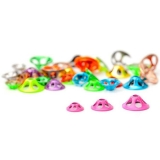Overview
Tube fly coneheads are specialised components added to tube flies to influence their action, profile and sink rate. These additions play a crucial role in determining the fly's behavior in the water, often making it more attractive to target species like salmon.
What are tube fly coneheads used for?
Coneheads serve several functions in tube fly design:
- Weight: They add weight to the fly, enabling it to sink faster and reach desired depths in the water column.
- Action: Coneheads can impart a unique, darting or jigging action to the fly as it's retrieved, which can be particularly enticing to fish.
- Profile: They can help create a streamlined head or modify the overall profile of the fly, often making it appear more realistic or noticeable.
- Attraction: With various colors and finishes available, coneheads can also serve as an additional attractor element on the fly.
Types of Tube Fly Coneheads:
Coneheads vary in design, material, and finish:
- Material: Most coneheads are made of metal, such as brass or tungsten. Tungsten is denser than brass, so tungsten coneheads are heavier for their size, allowing flies to sink faster.
- Size: Coneheads come in a range of sizes, from tiny cones for small tube flies to larger ones for big, articulated patterns.
- Finish: They can be plain metal, painted, or even have holographic finishes. Popular colors include gold, silver, black and various fluorescent shades.
- Shape: While the traditional conehead shape is, as the name suggests, conical, there are variations, including bullet-shaped or those with sculpted features.
Attaching Coneheads to Tube Flies:
The process of incorporating a conehead into a tube fly design is straightforward but requires some considerations:
- Order of Operations: Typically, the conehead is slid onto the tube before any tying begins. After the fly is tied, the tube is trimmed and the conehead is fixed in place, either by melting the tube behind it or using adhesives.
- Fit: It's essential to ensure the conehead's inner diameter matches the tube's outer diameter. Too loose, and the cone may slide; too tight, and it may not fit at all.
Choosing the Right Conehead:
When selecting a conehead for a particular tube fly design, consider the desired depth and action you want the fly to achieve, as well as the aesthetic appeal. Sometimes, it might be beneficial to have multiple versions of the same fly pattern with different coneheads to adapt to various fishing conditions.
In summary, coneheads are more than just decorative elements in tube fly tying. They play a vital role in how the fly functions underwater, influencing its movement, sink rate and overall profile. By understanding and experimenting with different coneheads, fly tyers can craft tube flies that are both visually appealing and highly effective in enticing salmon and other target species.



